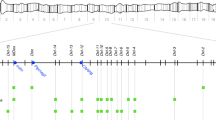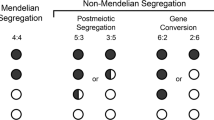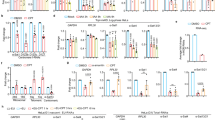Abstract
SATELLITE DNA refers to a class of tandem repeats of very simple sequences, usually A + T or G + C rich, which form a satellite band on a CsCl gradient. Their ubiquity and abundance in higher eukaryotes have led to speculation about their functions1–3 It has often been suggested that satellite DNAs are merely innocuous genetic parasites or comprise 'junk' DNA2–4. The recent identification of an array of satellite DNA repeats as the Responder (Rsp) locus of Drosophila melanogaster provides a new perspective on these elements5. Rsp is in the centromeric heterochromatin of most natural second chromosomes6. It causes spermatids bearing it to degenerate after meiosis when the homologous second chromosome is a Segregation Distorter (SD) chromosome. That is, SD targets the Rsp locus on its homologue for destruction during spermatogenesis, causing meiotic drive. Why then does the Rsp locus, a large array of satellite repeats, exist at all? One plausible explanation is that its existence contributes to the fitness of flies bearing it, compensating for the loss through meiotic drive. A direct demonstration of the usefulness of any family of satellite DNA is to compare the fitnesses of individuals with and without it. Previously, such an experiment has been difficult because the absence of a characteristic phenotype has precluded an efficient selection of deletion mutations. In this report we attempt to demonstrate a fitness reduction associated with the deletion of Rsp satellite DNA as well as the life stages at which such a reduction occurs.
This is a preview of subscription content, access via your institution
Access options
Subscribe to this journal
Receive 51 print issues and online access
$199.00 per year
only $3.90 per issue
Buy this article
- Purchase on SpringerLink
- Instant access to full article PDF
Prices may be subject to local taxes which are calculated during checkout
Similar content being viewed by others
References
Brutlag, D. L. A. Rev. Genet 14, 121–144 (1980).
Miklos, G. L. G. in Molecular Evolutionary Genetics (ed. Mclntyre, R. J.) 241–322 (Plenum, New York, 1985).
Ohno, S. in Evolution of Genetic Systems (ed. H. H. Smith) 366–370. (Gordon and Breach, New York, 1970).
Smith, G. P. Science 191, 528–535 (1976).
Wu, C.-l., Lyttle, T. W., Wu, M. L. & Lin, G. F. Cell 54, 179–189 (1988).
Ganetzky, B. Genetics 86, 321–355 (1977).
Pimpinelli, S. & Dimitri, P. Genetics 121, 765–772 (1989).
Crow, J. F. Scient. Am. 240, 134–146 (1979).
Charlesworth, B. & Hartl, D. L. Genetics 89, 171–192 (1978).
Hiraizumi, Y. & Thomas, A. M. Genetics 106, 279–292 (1984).
Temin, R. G. & Marthas, M. Genetics 107, 375–393 (1984).
Crow, J. F. & Kimura, M. An Introduction to Population Genetics Theory (Burgess, Minneapolis, 1970).
Wu, C.-l. Genetics 105(3), 651–662 (1983).
Lefevre, G. & Jonsson, U. B. Genetics 47, 1719–1736 (1962).
Hartl, D. L., Sandier, L. & Crow, J. F. Proc. natn. Acad. Sci. U.S.A. 58, 2240–2245 (1968).
Yamamoto, M., & Miklos, G. L. C. Chromosoma 66, 71–98 (1978).
Brittnacher, J. G. & Ganetzky, B. Genetics 121, 739–750 (1989).
John, B. & Miklos, G. The Eukaryote Genome in Development and Evolution. (Allen & Unwin, London, 1989).
Radio, M. A., Lundgren, K. & Hamkalo, B. A. Cell 50, 1101–1108 (1988).
Hsieh, C. H., & Griffith, J. D. Cell 52, 535–544 (1988).
Tokuyasu, K. T., Peacock, W. J. & Hardy, R. W. Z. Zellforsch. Mikrusk. Anal 124, 479–506 (1972).
Wu, C.-l. & Beckenbach, A. T. Genetics 105, 71–86 (1983).
Nur, U., Werren, J. H., Eickbush, D., Burke, W. & Eickbush, T. Science 290, 512–514 (1988).
Dorn, R., Heymann, S., Lindigkeit, R. & Reuter, G. Chromosoma 93, 398–403 (1986).
James, T. C. & Elgin, S. C. R. Molec. cell. Biol. 6, 3862–3872 (1986).
Strauss, F. & Varshavsky, A. Cell 37, 889–901 (1984).
Haldane, J. B. S. J. Genet. 54, 294–296 (1956).
Author information
Authors and Affiliations
Rights and permissions
About this article
Cite this article
Wu, CI., True, J. & Johnson, N. Fitness reduction associated with the deletion of a satellite DNA array. Nature 341, 248–251 (1989). https://doi.org/10.1038/341248a0
Received:
Accepted:
Issue date:
DOI: https://doi.org/10.1038/341248a0
This article is cited by
-
Mendel's First Law: partisan interests and the parliament of genes
Heredity (2022)
-
Interaction systems between heterochromatin and euchromatin inDrosophila melanogaster
Genetica (1994)
-
Two dispersed highly repeated DNA families of Triturus vulgaris meridionalis (Amphibia, Urodela) are widely conserved among Salamandridae
Chromosoma (1991)



